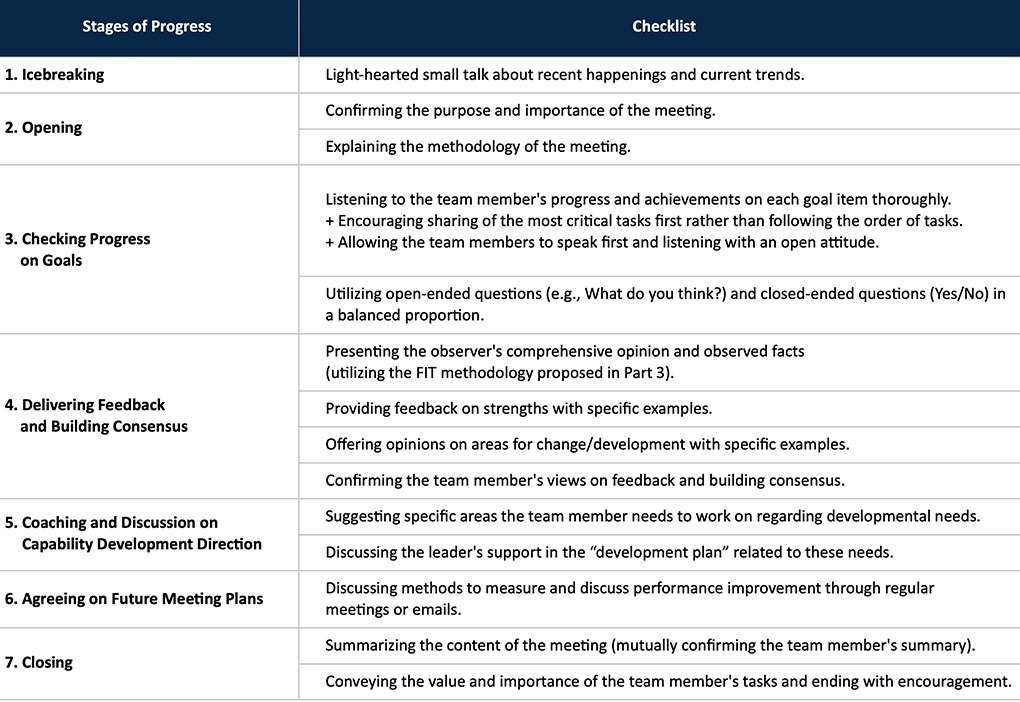

On Coaching and Feedback

Part 4. The Wow (What & How) of a Coaching Leader: How Must It Be Done?
Columnist
Ha kyungtae Amorepacific Leadership Development Team

It's already the fourth column, and through the previous ones, we've delved into the origins of coaching, its necessity (why) in our rapidly changing environment, and the ‘What’ of business coaching. This part focuses on the “practical methodologies of business coaching: How.” The How segment will be serialized in two sections.

The first “How” aspect of coaching
1. feedback is “sharing a pre-agreed meeting schedule and agenda” between the leader and team members.
[Schedule Planning] Ideally, regular meetings should be held in line with the progress cycle of the team member's tasks, and it's recommended to coordinate these meetings at least 2-3 days in advance. Team members need time to prepare the necessary materials and thoughts for the meeting. Requesting a meeting on the day or the day before can disrupt the scheduled work for that day, leading to a decline in preparedness and focus for the meeting.
[Agenda Sharing] A more productive meeting can be prepared by sharing the purpose and agenda of the meeting in advance. For instance, an email stating, “①The purpose of the meeting, ②Progress check on individual tasks, ③Coaching/feedback on key tasks, ④Discussion of support needed from the leader” can help participants organize and prepare their thoughts on what aspects to emphasize and what support to request.
2. The second element is”preparing a space and seating arrangement”where team members can fully concentrate on coaching/feedback without interruption.
If feedback related to work is conducted in an open space, the surrounding noise and glances can make it difficult for the team members to focus. This is especially true if the feedback is critical. Additionally, it's helpful to know about the psychological impact of seating positions/angles in a meeting room. Organizational psychologist Sharon Livingston argues that the psychological conditions vary depending on where one sits during a meeting. This can be illustrated in below Table 1. The first seating arrangement is what we typically imagine in a business meeting. However, this might not be effective in a 1:1 meeting that requires open communication. Since the directions faced by each party are opposite, a defensive attitude can be fostered. In 1:1 meetings, the third or fourth seating arrangements are recommended to reduce psychological distance and enhance communication with team members.

[Table 1] The Psychology of
Interpersonal Relations in
1:1 Meetings Based on Seating Positions
3. The third key element is“scenario-based coaching/feedback preparation.”
Even leaders with extensive experience often encounter unexpected variables and reactions from team members in 1:1 coaching/feedback situations, leading to considerable dismay. Thus, thorough preparation is essential for coaching/feedback, and I propose a coaching/feedback checklist to assist in this process.

[Table 2] Coaching/Feedback Checklist
As you can see from the checklist, the general flow should be clear. Let's examine critical points to emphasize at each stage.
+ During the opening, it's crucial to align mutual understanding by explaining the purpose and methodology of the meeting. The intent is not just to check tasks but to recognize the team member's strengths recorded during task execution, discuss areas for improvement, and share plans and support for capability development.
+ In checking the progress on goals, it's advisable to request the sharing of critical tasks in order of importance. Various conversations in a 1:1 meeting may lead to poor time management, missing out on essential issues, or not communicating necessary points. Therefore, it's recommended to prioritize tasks and conduct the meeting accordingly.
+ Discussion on the direction of capability development is not about delivering cliché remarks like ‘Feel free to talk to me anytime.’ It's ideal to have a concrete discussion about the support needed from the leader to enhance performance in the team members' tasks and reach a mutual agreement on the plan.
+ Finally, at the end of the meeting, it's imperative to listen to how the team member has understood the shared content and plans. Misunderstandings can occur during lengthy discussions, leading to wasted time and potential future misunderstandings. To prevent this, it's recommended to provide team members with the opportunity to summarize the content of the meeting.
4. It's about the “Differentiation and Utilization of Immediate versus Timely Feedback.”
As mentioned in previous columns, leaders should provide supportive and constructive feedback to their team members. The critical question is “when” to give feedback. This is incredibly challenging for constructive feedback. I will discuss using immediate and timely feedback to guide you through this dilemma.

[Table 3] Appropriate Timing and Method for Each Type of Feedback
In the case of supportive feedback, when a leader sees behavior that should be continuously maintained and encouraged within the team, it is advisable to give immediate and public feedback. The reason for immediate and public feedback is to send a message to the entire team that such behavior is supported and recognized within our team, fostering its spread. However, focusing supportive feedback on one team member can lead to misunderstandings of favoritism among others, so it's suggested to use a mix of public and private methods at a suitable frequency.
On the other hand, giving immediate feedback for constructive purposes can cause misunderstandings and hurt feelings. For instance, if a team member is late once or twice due to family care and is then given feedback for a punctuality issue, they might feel like their circumstances aren't understood and harbor resentment rather than acknowledge their mistake.
Therefore, constructive feedback should be given when the team member can accept it. When is the right moment? It's when the behavior doesn't stop at once or twice but shows a ‘trend’ of repetition. It's best to provide 1:1 feedback in a prepared setting.
I emphasize the need for continuous observation and fact-based records, devoid of inference, to identify these trends and support team member growth.
5. oaching/feedback is more effective when “continuously practiced.”
First, let me clarify that the coaching/feedback I refer to here is not advice/evaluation/judgment with a directive nature regarding work tasks. Directive feedback focuses more on the progression of a specific task rather than on changing or improving a team member's behavior. To truly develop team member capabilities and achieve results, it is essential to provide coaching/feedback based on continuously observed and recorded facts, either supporting the behavior or requesting change.
Now, let's return to the main topic and understand why continuous coaching/feedback is effective. Consider the following two coffee coupons, which most people use through apps. Coupon A offers a free drink after collecting ten stamps, while Coupon B starts with two pre-stamped out of 12, offering a free drink after collecting ten stamps. Which coupon, A or B, will more quickly have all its stamps collected?

This study was conducted in 2006 by a research team led by Professor Ran Kivetz at Columbia University. The results indicated that Coupon B was filled 20% faster than Coupon A. Although both coupons require the same number of stamps, Coupon A starts at 0% progress, while Coupon B begins at 16.7%. This creates a psychological illusion in customers, encouraging them to achieve their goals more quickly. This is known as the Goal Gradient Effect.
Let's apply the effect to our workplace and continue discussing Table 4.
When goals are set at the start of the year, the motivation towards achieving them typically shows an initial boost, often dwindling towards the mid-year, then picking up again in a U-shaped curve as year-end evaluations approach. This pattern may be familiar. In such situations, regularly monitoring the progress of tasks and providing coaching/feedback can sustain high motivation. In other words, periodic coaching/feedback can act like the pre-stamped stamps on a coffee coupon.

[Table 4] Motivation Towards Goal Achievement Over Time
Moreover, in our rapidly changing times, goals set at the beginning of the year might not always be applicable by the end. Therefore, consistent coaching/feedback throughout the process can enhance team members' capabilities and motivation levels and ensure the objectivity of evaluations.
To summarize today's discussion on How #1 of coaching/feedback:
First is sharing “pre-agreed meeting schedules and agendas” between leaders and team members.
Second, “preparing a space and seating arrangement” allows complete focus on coaching/feedback.
Third is the progression of “scenario-based coaching/feedback.”
Fourth is the differentiation and utilization of “immediate and timely coaching/feedback.”
Fifth is the “continuous practice of coaching/feedback.”
In this column, we have discussed the basic How #1 of coaching/feedback. In the upcoming fifth column, How #2, we will explore how leaders can tailor coaching/feedback for individual team members and how we can utilize the ongoing feedback feature in our AP&I system.
-
Like
4 -
Recommend
2 -
Thumbs up
2 -
Supporting
1 -
Want follow-up article
1




